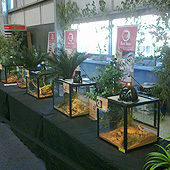Keeping the correct environment settings for a reptile vivarium is one of the most important things to take into consideration before bringing your pet home. In fact, it is essential that you recreate a reptile’s natural environment as diligently as possible in order to keep them healthy and happy. Undeniably, a vivarium makes it possible to easily control numerous variables like lighting, heat and humidity.
Although the complexity of maintaining the right environment settings for a reptile vivarium may seem complicating, it is really quite simple and fascinating. Plus, learning about your reptiles necessities can be a captivating process. In addition, decorating and creating the reptiles new home is a lot of fun.
The Structural Design
A vivarium is generally composed of wood which can have a loose or fitted substrate. It is generally filled with exotic live plants, thermostats, LED lighting and ceramic heaters. Although some vivariums are made of hard plastic, wood is the preferred material. This is because wood is ideal for insulation and prevents heat from escaping. However, the type of equipment needed for the perfect environment all depends on the type of reptile you acquire. For instance, frogs and other amphibians actually need a glass terrarium so that temperatures can be better regulated.
The Correct Temperature
It is recommended that you set up a heat bulb at one end of the vivarium in order to achieve the correct temperature. As well, the reptile should not be able to touch the heat source as it can lead to severe burns. For prevention of injury, a protective heat guard is all that is needed.
A quality thermostat is also needed so that you can regulate the temperature. If you bulb emits light and heat then a dimming thermostat is recommended. If your bulb does not emit light then a pulse stat is a good choice.
In addition, you should programme your thermostat so that you maintain the correct temperature and do not allow the vivarium to get to hot. Overheating the vivarium can do irreparable damage and harm to your reptile. Importantly, one temperature does not fit all. All reptiles require different temperatures. This is why most thermostats are designed to adapt to different types of bulbs and settings.
In fact, the UVB light you need is directly dependent upon the type of reptile you have. Also; snakes, arachnids, amphibians and leopard geckos do not need UVB light. However, you can provide a day and night cycle with a UVB of 2%.
Reptiles from the forest like green iguanas and chameleons require a UVB of 5%. They are also best kept in a terrarium. Desert reptiles such as bearded dragons need a UVB of 10%.
It is also highly recommended that you change your UVB tubes about every 6-8 months. When the UVB tubes emits fewer rays, your reptile will absorb less calcium.
Substrate
Reptiles require different substrates depending on their natural environment. For the most part, many specialists recommend that you use the substrate best suited for your reptile. Some of the substrate include sand, soft chips, cage carpet and sphagnam moss.

